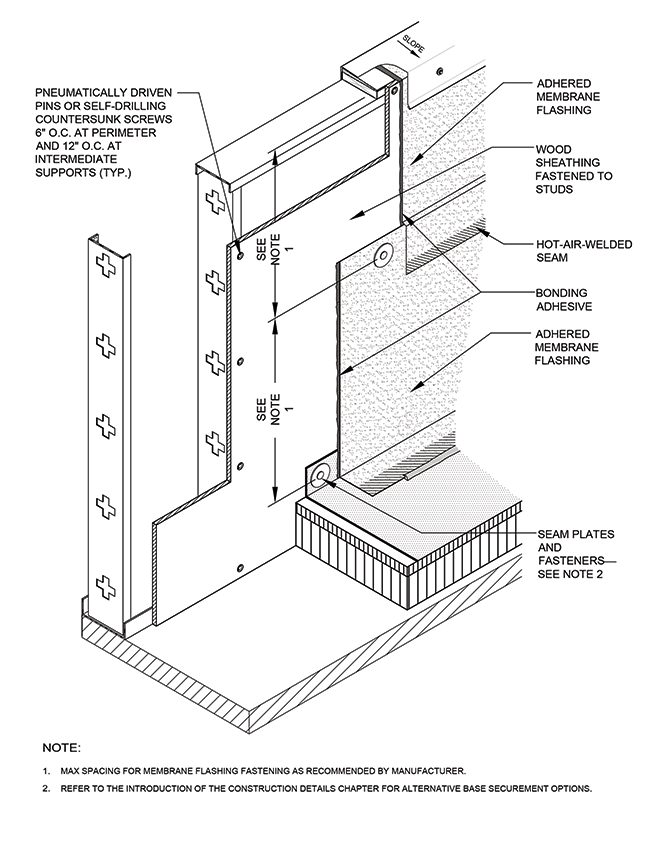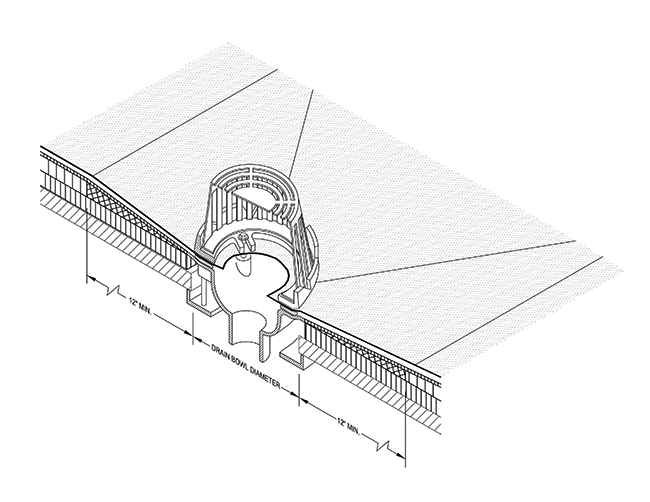This month, NRCA released The NRCA Roofing Manual: Membrane Roof Systems—2019, the latest volume in The NRCA Roofing Manual series. This volume replaces The NRCA Roofing Manual: Membrane Roof Systems—2015. The new volume provides up-to-date NRCA best practice guidelines for the design and installation of membrane roof systems, including built-up roof membranes, polymer-modified bitumen membranes, thermoset and thermoplastic single-ply membranes, and liquid-applied membranes.
The outline
The updated manual uses the same 10-chapter format as the previous volume and is formatted as a reference manual. Designers who intend to use the publication as a guide for designing roof assemblies should start at the beginning in Chapter 1—Roof Assembly Configurations and select a roof assembly configuration that fits a project's basic description. Each configuration includes a list of applicable roof assembly components with references to where detailed information about each component is located.
Chapters 2 through 8 are arranged to address each of the following roof assembly components in order from bottom to top of typical roof assemblies: roof decks, air and vapor retarders, rigid board insulation, roof membranes, fasteners, surfacings and roof accessories.
Chapter 9—Reroofing addresses re-covering existing roof systems with new membrane roof systems and roof system removal and replacement.
Chapter 10—Construction Details provides construction details for commonly encountered roof perimeter and penetration conditions.
And five appendixes address additional subject matter related to the design and installation of membrane roof assemblies.
Strike out "fully"
The manual eliminates the use of the term "fully adhered" as a description of roof membrane and rigid board insulation applications. Some specifiers and manufacturers apply this term to adhered applications of single-ply roof membranes and rigid board insulation. NRCA recommends the term fully adhered be avoided when describing field applications because the description creates an unrealistic expectation of adhesion over 100 percent of the contact area that is impractical in field applications. Instead, NRCA suggests the industry use the term "adhered." For a discussion of arguments explaining this change, see "The fully adhered misnomer."
Other significant changes include:
Updated content by chapter
With the exception of Chapter 8—Roof Accessories, each chapter in the volume has been revised to some extent. If you regularly have used the 2015 volume as a reference source, the following information will help you smoothly transition to using the 2019 volume.
Built-up roofing (BUR) and polymer-modified bitumen temporary roof assembly configurations were added in Chapter 1—Roof System Configurations. Commonly, where temporary roof systems are specified, they are bituminous membranes. A temporary roof system may be installed as a sacrificial traffic surface or to dry in a building before permanent roof system installation. A temporary roof system may function as a vapor retarder in a finished roof assembly, or it may be removed.
Appendix A3—Temporary Roof Systems expands information previously published in The NRCA Roofing and Waterproofing Manual, Fifth Edition. This appendix provides design guidelines for temporary roof systems, including information about temporary roof system drainage design.
In Chapter 2—Roof Decks, sections addressing lightweight insulating concrete decks, steel decks and lightweight structural concrete decks were updated. NRCA approached lightweight insulating concrete manufacturers for comments about existing NRCA recommendations, and the updated section contains revisions based on comments received.
In the steel deck section, the Steel Deck Institute's recommendations for dimensional tolerances for steel roof deck panels were added, and text addressing FM Global guidelines for the attachment of steel roof decks was rewritten.
Revisions to the discussion of lightweight structural concrete call attention to characteristics that set it apart from typical weight structural concrete and contribute to moisture-related problems associated with lightweight structural concrete roof decks.
In Chapter 3—Air and Vapor Retarders, the discussion of roof assembly air retarder design for energy code compliance was expanded. NRCA added recommendations for designs where an air-impermeable roof membrane functions as the roof assembly air retarder. This update was based on NRCA's Guidelines for Air Retarders in Roof Assemblies published in 2017.
Text in Chapter 4—Rigid Board Insulation provides updated recommendations for storage and handling protection of rigid board insulation. NRCA considers manufacturers' factory-applied plastic insulation packaging to be an appropriate water-resistant covering for short-term outdoor storage provided it is intact. When separate water-resistant coverings are used, NRCA prefers breathable (vapor-permeable) coverings, such as water-resistant tarpaulins. Also in Chapter 4, sections discussing expanded polystyrene, extruded polystyrene and stone wool roof insulation were revised based on comments received from manufacturers.
Revisions in Chapter 5—Roof Membranes are concentrated in Section 5.3—Polymer-modified Bitumen Roof Membranes. New cautionary language concerning torch-applied applications has been added. NRCA stresses its concern with fire safety and prevention during the application of torch-applied polymer-modified bitumen sheet products. The potential for fire is particularly concerning during the installation of torch-applied polymer-modified bitumen sheets over combustible substrates, such as wood panel sheathing, wood board and plank sheathing, and wood blocking. NRCA considers the potential fire risk associated with these applications to outweigh any advantages torch-application provides.
With this update of The NRCA Roofing Manual, NRCA no longer recommends designers specify torch-applied polymer-modified bitumen membranes over combustible substrate roof decks even when a thermal barrier insulation layer has been laid over the combustible roof deck. NRCA recommends alternative application methods, such as cold-adhesive application, when polymer-modified bitumen roof membranes are being specified over combustible roof decks.
However, NRCA considers torch-applied application of polymer-modified bitumen sheet flashings over combustible substrates by the direct torching method to be appropriate when air-impermeable backers have been installed and low-output (105,000 BTU or less) torching equipment is used.
Information about asphalt core boards used as components of polymer-modified bitumen roof systems has been revised and relocated from Chapter 4 to Section 5.3. For roofing applications, asphalt core board may be used as a substrate for torch-applied, cold-adhesive applied and self-adhering asphalt-based membranes and flashings. It may be installed over structural substrates, rigid board insulation and existing roof membranes. Asphalt core boards are not intended for use as cover boards or substrates for wall flashings without additional support. The applicable material standard, Canadian standard CSA A123.25, "Asphalt core boards used in roofing," does not provide minimum mechanical strength requirements suitable for those uses.
Revisions in Chapter 6—Fasteners emphasize a designer's responsibility to determine the required fastener spacings in a roof's field, perimeter and corner regions and clearly indicate this information in the project's drawings and specifications. NRCA recommends designers determine the required fastener layouts at these locations based on manufacturers' test data.
Chapter 6 references Appendix A1—Wind Uplift. This appendix provides information about determining design wind loads for the field, perimeter and corner roof regions. It has been updated to address changes in wind design procedures introduced in the 2016 edition of ASCE 7, "Minimum Design Loads and Associated Criteria for Buildings and Other Structures." International Building Code,® 2018 Edition (IBC 2018), Chapter 16—Structural Design references ASCE 7-16 for determining building design loads including wind loads.
The Chapter 7—Surfacings section addressing roof coatings was revised based on a review conducted by Roof Coatings Manufacturers Association (RCMA) members. NRCA approached RCMA with a review request and received extensive comments regarding rewording text for accuracy.
In Chapter 9—Reroofing, revisions affect the discussion of roof decks for reroofing. In sections addressing existing structural concrete and lightweight insulating concrete roof decks, revisions parallel changes introduced in Chapter 2. Updated guidelines for existing wood panel roof decks address reattachment of roof sheathing to framing in membrane roof assemblies and reference APA—The Engineered Wood Association recommendations. Chapter 9 includes code commentary regarding IBC Section 1511—Reroofing.

Figure 1: Base securement for thermoplastic membranes at a steel stud wall with wood sheathing fastening substrate
Revisions in Chapter 10—Construction Details address flashing conditions that have increasingly challenged installers since adopted energy codes introduced significant increases in roof insulation thickness: single-ply membrane base flashing securement at stud walls and flashing roof drains with extensions where temporary roof systems are installed to dry in buildings early during new construction. Chapter 10 references New Appendix A3—Temporary Roof Systems for additional information. New figures illustrate NRCA recommendations for base flashing securement at stud walls (see Figure 1). Drain sump flashing guidelines were redrawn in isometric view (see Figure 2). Two new details address roof drain flashings with temporary roof systems for BUR and polymer-modified bitumen roof systems.

Figure 2: Drain sump guidelines
Six appendixes are included; all but one are new to this volume. In addition to Appendix A1-Wind Uplift and Appendix A3—Temporary Roof Systems, the following appendixes appear:
Also, the 2015 appendix addressing guidelines for rooftop photovoltaic installations was removed. Instead, the 2019 manual references NRCA Guidelines for Rooftop-mounted Photovoltaic Systems, Second Edition, published in 2018.
Download it for free
NRCA encourages all NRCA members to visit the NRCA Bookstore at www.nrca.net/store to download a free PDF of the manual. Hard copies also can be purchased. Nonmembers may purchase a hard or electronic copy.
Maciek Rupar is an NRCA director of technical services.
Take advantage of electronic availability
Free downloads of The NRCA Roofing Manual and all other NRCA technical publications are included as part of NRCA membership. Member employees can download PDF copies for personal use and always be current with published NRCA guidelines.
Available downloads are denoted as electronic products in NRCA's online bookstore, www.nrca.net/store. Nonmembers also may download electronic copies for a fee.
COMMENTS
Be the first to comment. Please log in to leave a comment.